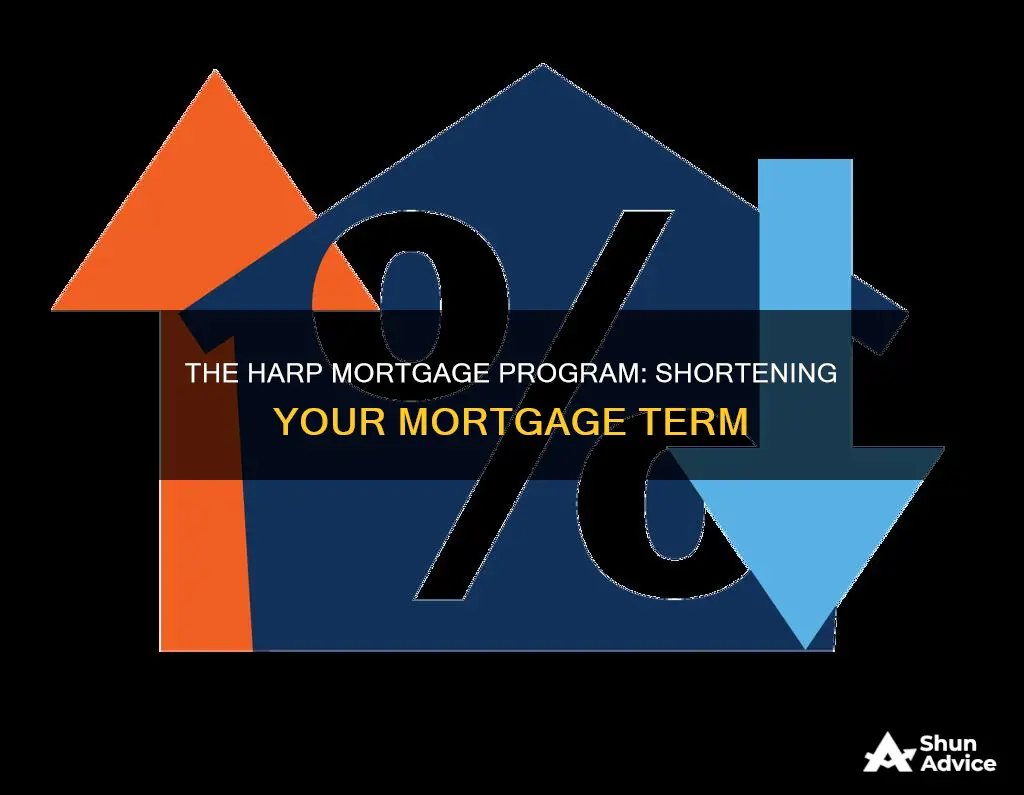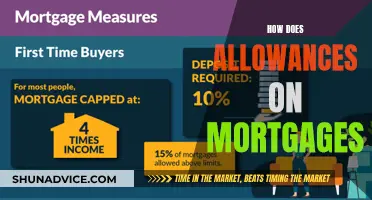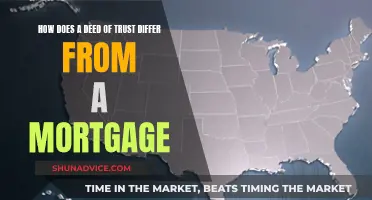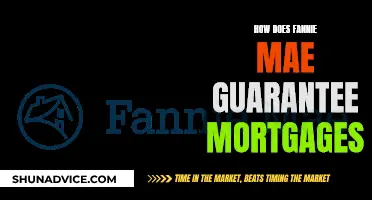
The Home Affordable Refinance Program (HARP) was a government-backed program that allowed homeowners to refinance their mortgages at more attractive interest rates. The program was designed to help borrowers with a loan-to-value ratio (LTV) of greater than 80% who were unable to secure refinancing due to a lack of equity in their homes. While HARP did not reduce the amount owed, it offered lower interest rates and monthly payments, helping borrowers save money in the long term. HARP allowed for refinancing into a shorter-term loan, enabling faster equity building and considerable interest savings. However, it is important to note that HARP expired in 2018 and is no longer available.
| Characteristics | Values |
|---|---|
| Purpose | To help homeowners refinance loans on properties that were worth less than their outstanding mortgage |
| Target | Borrowers with a loan-to-value ratio (LTV) of greater than 80% |
| Eligibility | No minimum credit score; no maximum LTV ratio for fixed-rate mortgages; adjustable-rate mortgages have a maximum LTV of 105% |
| Requirements | On-time monthly payments; no delinquency on mortgage payments; no more than one 30-day late payment in the preceding 12 months |
| Expiry | December 31, 2018 |
| Outcome | Lower interest rates and monthly payments; faster equity building; considerable interest savings and lower rates and fees |
What You'll Learn

HARP eligibility requirements
The Home Affordable Refinance Program (HARP) was a federal program set up by the Federal Housing Finance Agency in March 2009 to help underwater and near-underwater homeowners refinance their mortgages. The program ended in 2018, so eligibility is no longer a concern for prospective applicants. However, for reference, here are the eligibility requirements that were in place for HARP:
- The mortgage must be owned or guaranteed by Freddie Mac or Fannie Mae.
- The mortgage must have been acquired by Freddie Mac or Fannie Mae on or before May 31, 2009.
- The homeowner must not have previously refinanced the mortgage under HARP, unless it is a Fannie Mae loan that was refinanced under HARP during March–May 2009.
- The homeowner must be current on their mortgage payments, with no (30-day) late payments in the last six months and no more than one late payment in the last twelve months.
- The current loan-to-value ratio (LTV) of the property must be greater than 80%.
- The homeowner must benefit from the loan by either lower monthly payments or movement to a more stable product with a fixed interest rate.
- The mortgage must be securitized prior to June 1, 2009. In general, this means that your mortgage must have started in mid-May 2009 or earlier.
- The homeowner must have private mortgage insurance (PMI) or lender-paid mortgage insurance (LPMI).
It is important to note that there may have been additional criteria imposed by the mortgage servicer, and eligibility requirements could change over time.
Mortgage Debt: A Divorce Complication
You may want to see also

HARP loan term limits
The Home Affordable Refinance Program (HARP) was a government program designed to help distressed or underwater homeowners refinance mortgages at more attractive interest rates. The program started on April 1, 2009, and ended on December 31, 2018.
HARP was aimed at borrowers who had a loan-to-value (LTV) ratio of greater than 80%. These borrowers often have trouble securing refinancing because of a lack of equity in their homes, and thus they cannot benefit from falling interest rates. The HARP program had no minimum credit score or maximum LTV ratio requirements.
HARP did not decrease the amount owed by borrowers, but it did help them secure lower interest rates and monthly payments. The program also allowed borrowers to refinance into a shorter-term loan, which helped them pay off their mortgage faster and save on interest over the life of the loan. While there was no maximum LTV ratio for fixed-rate mortgages, adjustable-rate mortgages had a maximum LTV of 105%.
HARP was replaced by the Streamline Refinance program, which has no minimum credit score, maximum debt-to-income ratio, or maximum LTV. This program encourages borrowers to swap to 15- or 20-year terms, which offer faster equity building and considerable interest savings.
Halving Mortgage Payments: Save Money, Interest Costs
You may want to see also

HARP's impact on interest rates
The Home Affordable Refinance Program (HARP) was a government program designed to help distressed homeowners refinance their mortgages at more attractive interest rates. The program was launched in 2009 in response to the 2007-2008 financial crisis, which saw a crash in the real estate market and a wave of predatory lending practices that left many homeowners "underwater" on their mortgages.
HARP was specifically aimed at borrowers with a loan-to-value (LTV) ratio of greater than 80%. These borrowers typically have difficulty securing refinancing because of a lack of equity in their homes, and thus cannot benefit from falling interest rates. HARP provided a way for these homeowners to refinance their mortgages at lower interest rates, thereby reducing their monthly payments.
The program was available only to homeowners who had conventional mortgages sold to or guaranteed by Fannie Mae or Freddie Mac. Additionally, borrowers had to be current on their mortgage payments and could not have any late payments over the past six months. There was no minimum credit score requirement.
HARP did not decrease the amount owed by borrowers, but it did help millions of homeowners refinance their underwater mortgages at lower interest rates, thereby reducing their monthly payments. This allowed them to build up equity in their homes and avoid foreclosure.
HARP ended on December 31, 2018, but refinancing options for distressed homeowners are still available through programs offered by Fannie Mae and Freddie Mac, as well as other government-backed programs such as the Federal Housing Administration's (FHA) streamline refinance program and the Veterans Affairs Interest Rate Reduction Refinance Loan (VA IRRRL) Program.
Removing the Deceased's Name from a Mortgage
You may want to see also

HARP's role in building home equity
The Home Affordable Refinance Program (HARP) was a government-backed program that helped underwater homeowners with refinancing mortgages at more attractive interest rates. HARP played a significant role in building home equity for borrowers by offering the following:
Lower Interest Rates and Monthly Payments
HARP allowed borrowers to refinance their mortgages at lower interest rates, reducing their monthly payments. This not only provided immediate financial relief but also helped borrowers build equity in their homes over time.
Increased Affordability
The program was specifically designed for borrowers with a loan-to-value (LTV) ratio of greater than 80%, who typically faced challenges in securing refinancing due to a lack of equity in their homes. By targeting this group, HARP made it more affordable for borrowers to refinance and build equity.
No Maximum LTV Ratio for Fixed-Rate Mortgages
HARP did not impose a maximum LTV ratio for fixed-rate mortgages, allowing borrowers with high LTV ratios to still qualify for refinancing. This feature was particularly beneficial for those with limited or negative equity, helping them access more favourable loan terms and build home equity faster.
Shorter Loan Terms
HARP offered borrowers the option to refinance into shorter-term loans, such as 15- or 20-year terms. Shorter loan terms result in faster equity building, as borrowers pay down the principal balance more quickly and accrue less interest over the life of the loan.
Access to Other Refinancing Options
Even though HARP has since expired, it paved the way for other refinancing programs offered by Fannie Mae and Freddie Mac. These programs continue to provide distressed borrowers with opportunities to refinance their mortgages, build equity, and improve their financial situations.
Mortgages and Net Worth: What Homeowners Need to Know
You may want to see also

HARP alternatives
The Home Affordable Refinance Program (HARP) was a government program designed to help distressed homeowners refinance their mortgages at more attractive interest rates. The program ended on December 31, 2018, but there are several alternatives that serve similar purposes:
Fannie Mae's High Loan-to-Value Refinance Option (HIRO)
This program is designed to help homeowners with little or no equity to refinance their mortgages for a lower interest rate. To be eligible, you must have a conventional loan with a high loan-to-value (LTV) ratio of at least 97.01% and an existing Fannie Mae mortgage originated on or after October 1, 2017.
Freddie Mac Enhanced Relief Refinance (FMERR)
This was Freddie Mac's HARP replacement program that expired on September 30, 2019. It was designed for borrowers who were current on their mortgage payments but had limited equity in their homes.
Federal Housing Administration's (FHA) Streamline Refinance Program
This program is designed to help homeowners who have little to no equity in their homes to refinance their mortgages. It is a government-backed program that offers more lenient qualifying requirements than standard refinance programs.
Veterans Affairs Interest Rate Reduction Refinance Loan (VA IRRRL) Program
This program is designed to help veterans and service members refinance their VA home loans to obtain a lower interest rate or switch to a more stable home loan product.
Home Affordable Modification Program (HAMP)
This program was a loan modification program that expired in 2016. It altered the terms of a mortgage, such as loan repayment terms and interest rates.
Retirement Savings: Easier Mortgage Approval with a 401k
You may want to see also
Frequently asked questions
The Home Affordable Refinance Program (HARP) was a government-backed program designed to help underwater homeowners with negative equity in their homes refinance mortgages at more competitive interest rates.
The HARP mortgage program allows homeowners to refinance to a shorter-term loan with a term of 30 years or fewer. This helps to build equity faster, save on interest over the life of the loan, and pay off the mortgage faster.
To be eligible for the HARP mortgage program, homeowners must have a mortgage owned or guaranteed by Freddie Mac or Fannie Mae, closed on or before May 31, 2009, and an LTV ratio of at least 80%. Additionally, borrowers could not be delinquent on their mortgage payments, with no more than one 30-day late payment in the preceding 12 months.
The HARP mortgage program ended on December 31, 2018. While the program is no longer available, there are other government-backed programs and refinance options available to help homeowners, such as programs offered by Fannie Mae and Freddie Mac.







